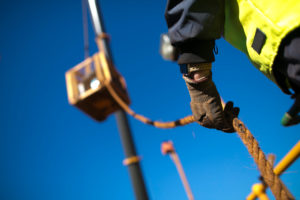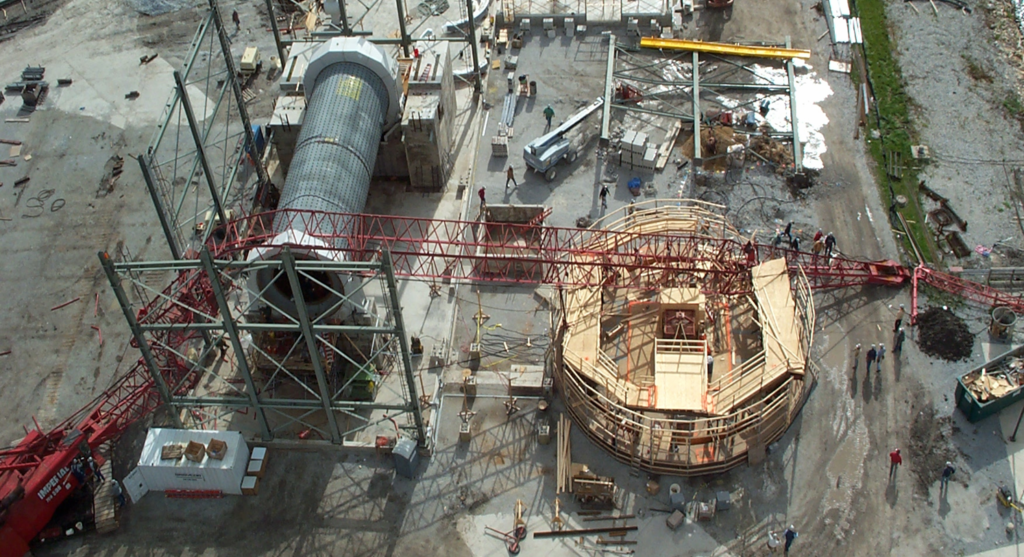The adequacy of a crane’s load line to support the weight of the object being lifted is an obvious concern when evaluating a crane lifting operation. Less obvious, but often equally important, is the presence and adequacy of taglines to provide control of the load orientation.
Taglines are simply ropes or lines that are connected to the load and controlled by personnel on the ground holding the opposite end of the line. Taglines must be large enough to be easily grasped and must be made of electrically non-conductive material. Taglines can be purchased as a manufactured product or fabricated locally from available materials.
Without taglines, crane loads can swing, rotate, or even spin, causing an increased chance of injury to personnel on the ground, damage to the load, or damage to the crane. The need for taglines increases with the physical size (and resulting sail area for wind to act on) of the load and strong or gusty wind conditions. Taglines aid in the exact placement and orientation of a lowered load without the need for personnel to come into close contact to manhandle the load into its final position.
Lift planning should include evaluation of the number and length of taglines required and the designation of the tagline handlers. One tagline may be adequate for a small load such as a pallet. Additional taglines are needed for loads that are more difficult to control. Tagline handlers work under the supervision of the lift director and must remain alert to control the load and prevent the tagline from catching or snagging and causing a loss of load control.
Both OSHA and industry standards require the use of taglines unless the load configuration and weather conditions are such that load control is not needed. The use of taglines is a well known practice that is often addressed by company policies and training in addition to the OSHA requirements and industry standards.
OSHA in CFR1926.1401 (Cranes and Derricks in Construction – Definitions) states “Tagline means a rope (usually fiber) attached to a lifted load for purposes of controlling load spinning and pendular motions or used to stabilize a bucket or magnet during material handling operations”. CFR1926.1417(w) (Cranes and Derricks in Construction – Operations) states “A tag or restraint line must be used if necessary to prevent rotation of the load that would be hazardous”. CFR1926.1431(k)(5)(Cranes and Derricks in Construction- Hoisting Personnel) requires “taglines must be used when necessary to control the platform”. CFR1910.180(h)(3)(XVI (Materials Handling and Storage- Crawler and Locomotive Cranes) applies to crane use outside of construction and states “A tag or restraint line shall be used when the rotation of the load would be hazardous”
ASME B30.5, Mobile and Locomotive Cranes, is the primary industry standard governing the design, maintenance, and operation of mobile and locomotive cranes. Chapter 5.3 of this standard addresses the operation of cranes. Paragraph 5-3.2.1.5(o) provides precautions for moving a crane with a load and states “Tag or restraint lines should be used to control swinging of the load”. Paragraph 5-3.2.1.5(q) provides precautions for rotating a crane with a load and states “A tag or restraint line shall be used when rotation of the load is hazardous”.
Despite these requirements and standards, many of the crane incidents investigated by Warren have involved lifts that were attempted without taglines or with inadequate taglines. The figure above shows a large crawler crane that overturned when the tagline handlers released taglines that were too short to allow a concrete plant wall section to be lifted over a tall portion of the structure. The section rotated 90 degrees after the taglines were released and could not be lowered into its intended position. Rather than abort the lift and return the wall section to its original location, a decision was made to lower the crane boom enough that the taglines could be recovered and the wall section rotated back to its intended orientation. The crane tipped over as the boom was lowered. Several people were nearly hit by the crane and the wall section, the crane and wall section were destroyed, and the construction project was delayed. All of this could have been avoided if the need for longer taglines had been identified during the planning process or if the lift had been halted before the handlers had to release their taglines.
John Phillips, senior consulting engineer at Warren, has more than 35 years of crane and heavy equipment experience and more than 25 years of experience in forensic engineering. A licensed professional engineer in South Carolina, North Carolina, Georgia, Louisiana and Ohio, he’s NCEES registered both as a model engineer and with The United States Council for International Engineering Practice, USCIEP. John has designed crane systems, supervised installation, tested and certified lifting equipment even serving as a project engineer for maintenance and certification of nuclear weapon lifting and handling systems. His extensive experience helps him determine the cause and scope of damage for crane, hoist and other lift equipment incidents.






